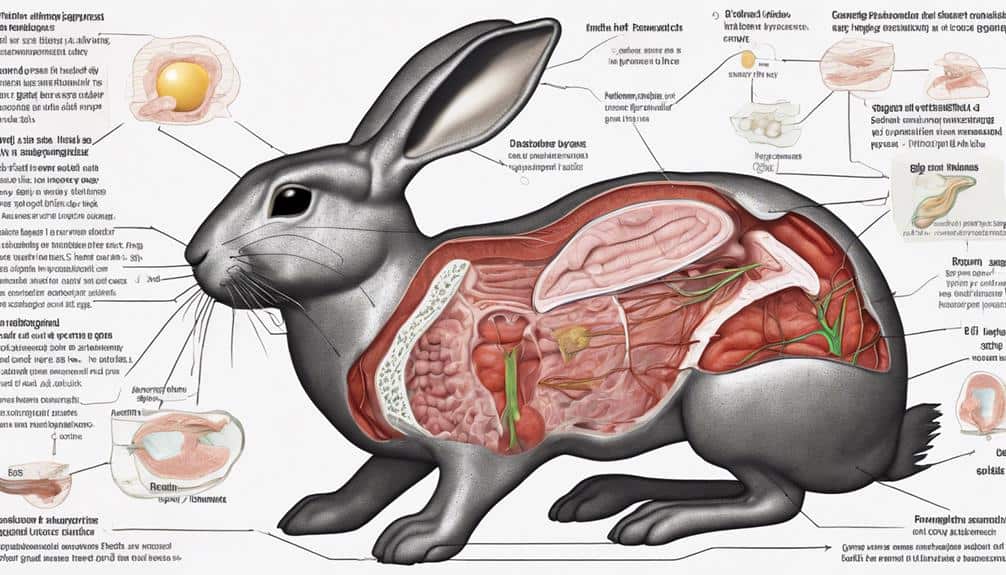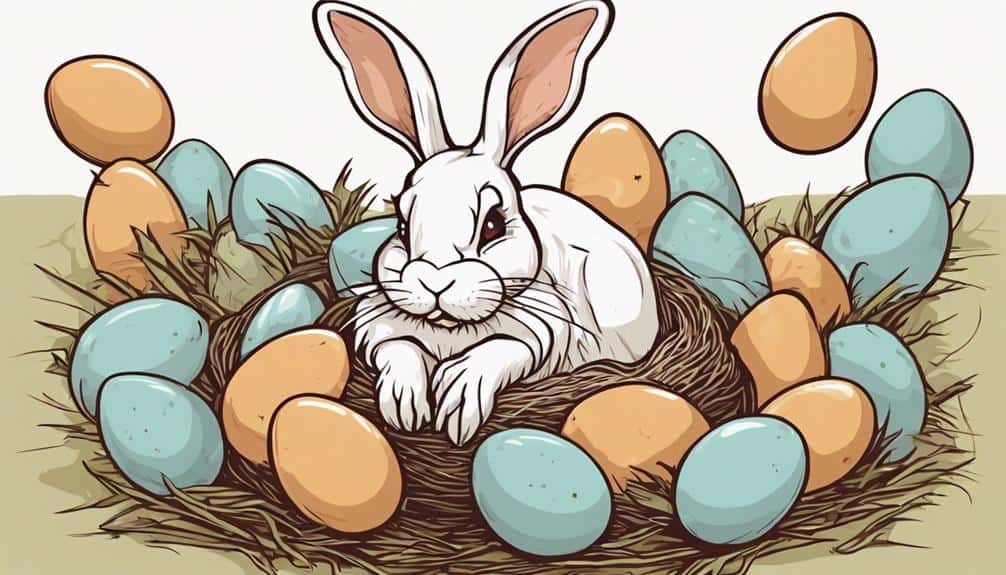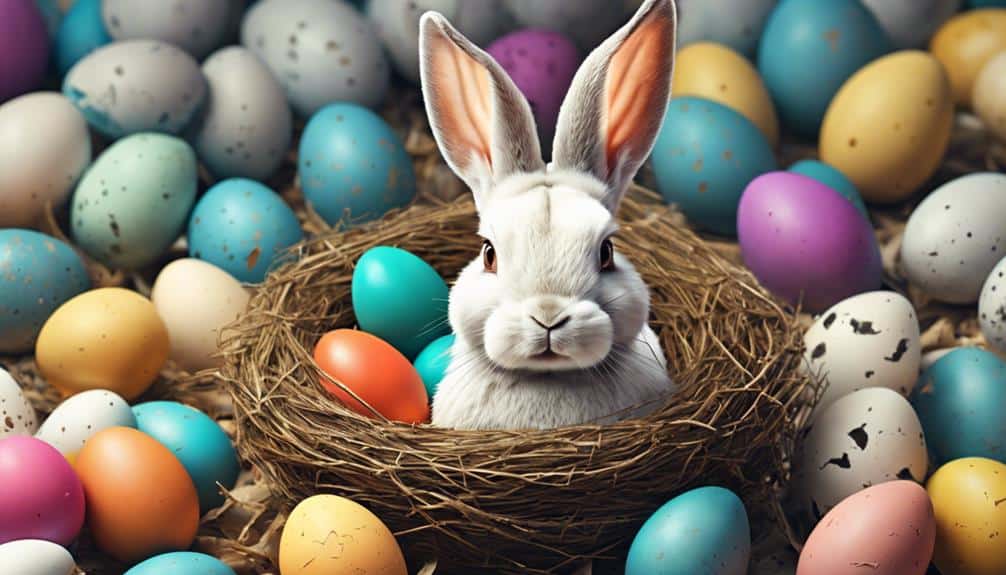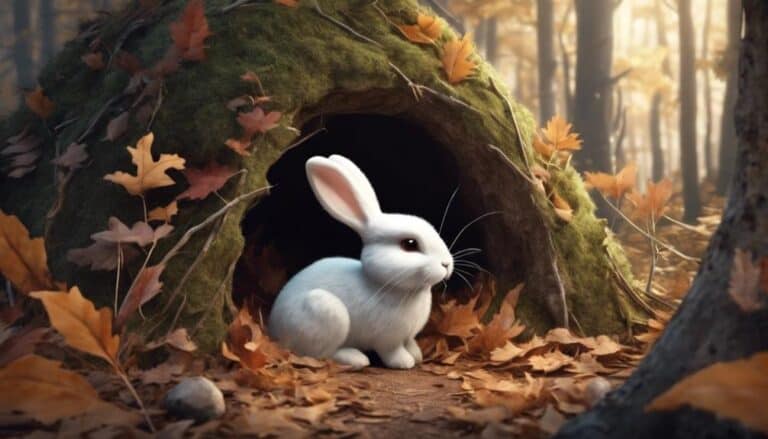Bunnies don't lay eggs, they actually give birth to live young called kits. The pregnancy only lasts around 31-33 days, and the baby bunnies develop inside their mother's body, getting all the nourishment they need through the placenta. Once born, the mother bunny takes care of her offspring by providing them with milk for their growth and development.
The idea of bunnies laying eggs actually comes from old stories and beliefs where eggs were seen as a symbol of fertility and new beginnings. This belief has carried on through the years and is now a part of traditions like the Easter bunny and eggs tradition. It's interesting to learn about the biology of how bunnies reproduce and the truth behind their life cycle.
Contents
- 1 Key Takeaways
- 2 Bunny Reproductive System
- 3 Myth of Bunny Eggs
- 4 Easter Symbolism Explained
- 5 Biology of Live Birth
- 6 Misconceptions About Bunnies
- 7 Egg-Laying Animals Vs. Mammals
- 8 Fertility Symbols in Culture
- 9 Bunny Pregnancy and Birth
- 10 Scientific Explanation of Bunny Reproduction
- 11 Debunking the Bunny Egg Myth
- 12 Frequently Asked Questions
- 13 Conclusion
Key Takeaways
So, bunnies don't lay eggs like birds or reptiles do. Instead, they have live babies after a short pregnancy. It's like how humans and other mammals give birth to their young.
When bunnies reproduce, they don't lay eggs at all! They're placental mammals, which means they give birth to live babies. The whole eggs and bunnies thing actually comes from old stories and symbols, not from real bunny biology.
To understand how bunnies make babies, you need to know that they have a typical mammal reproductive system. This means they mate, have internal fertilization, and then carry their babies until they're ready to be born. So, no eggs involved in the process! It's all about live births for these adorable fluffy creatures.
Bunny Reproductive System

Bunnies have a pretty cool way of making baby bunnies. They're placental mammals, so they give birth to live babies after about a month-long pregnancy. While inside the mother bunny's womb, the embryos grow quickly. After around 31-33 days, the mama bunny has a litter of baby rabbits, called kits. These little ones are born without fur, unable to see, and rely completely on their mom for everything.
The mother bunny takes care of her babies by nursing them and making sure they're fed and healthy. It's crucial for their growth and development.
Rabbits are smart reproducers. Females can get pregnant soon after having babies. This thing called superfetation lets a female rabbit carry two litters at different stages at the same time. It helps the species survive by having more babies in a short time, which is super important for prey animals like rabbits.
Myth of Bunny Eggs
Ever wondered why some people talk about bunny eggs?
Let's dive into where this myth comes from and how it's connected to Easter.
Bunny Egg Origins
Have you ever wondered where the whole idea of bunny eggs comes from?
Well, in ancient folklore, there's a pretty cool legend about a goddess and a magical transformation that explains it all. Bunny eggs are actually packed with meaning, representing stories of fertility and the rebirth of nature.
The tale goes like this: a goddess once changed a bird into a snow hare, which then started laying colorful eggs to symbolize fertility and new beginnings. This connection between bunnies and eggs is all about showing how nature goes through cycles of renewal and growth.
As time went by, this legend got mixed up with Easter traditions, leading to the Easter bunny and eggs we know today. The myth of bunny eggs is more than just a cute story – it holds a lot of cultural importance.
Bunnies and eggs have come to stand for hope, progress, and fresh starts in many different cultures.
Egg-Laying Misconception
There's a widespread misconception about bunnies laying eggs, often fueled by the Easter tradition of associating bunnies with eggs. Let's clear this up: bunnies don't lay eggs. They're placental mammals, which means they give birth after a 31-33 day pregnancy. So, no bunny eggs here!
The phrases 'Do bunnies lay eggs' and 'Do rabbits lay eggs' get searched a lot every month. This shows the need to spread the word about the real way rabbits reproduce. Knowing these facts can help correct the idea that bunnies lay eggs, especially for those looking for accurate information.
Bunny Reproduction Facts
Bunnies don't lay eggs; they actually give birth to live babies after a short 31-33 day pregnancy. When a female bunny, called a doe, is around 4-6 months old, she can start having babies multiple times a year. It's kind of cool how rabbits have this thing called induced ovulation, where mating triggers the release of eggs for fertilization.
After the eggs are fertilized, they grow into embryos inside the mother's uterus. The embryos get all their nutrients through this thing called the placenta until they're ready to be born. Rabbit moms are super caring and make cozy nests for their babies, taking care of them until they're big enough to eat on their own. It's really sweet to see how bunnies look after their little ones during the whole birth process.
Easter Symbolism Explained
Easter is all about new beginnings and fresh starts. That's why bunnies and eggs are such important symbols during this time. They represent fertility, growth, and the beauty of life springing anew. Across different cultures, bunnies and eggs are seen as signs of rebirth and the coming of spring.
The story behind the Easter bunny is pretty interesting. Legend has it that a goddess once turned a bird into a snow hare that laid colorful eggs. This tale shows how the bunny and egg are connected as symbols of transformation and new beginnings.
People from all over the world see the Easter bunny and eggs as key parts of their Easter celebrations. These symbols hold meaning beyond just cute decorations or fun egg hunts. They speak to our shared desire for prosperity, growth, and the natural cycle of life.
Whether you're hunting for Easter eggs or admiring bunny-themed decorations, these symbols remind us of hope and the wonder of new life. The Easter bunny and eggs bring people together, crossing boundaries and uniting us all in the joy of Easter.
Biology of Live Birth

Bunnies are mammals, so they've live babies instead of laying eggs. For rabbits, this means they get pregnant through internal fertilization and carry their embryos inside their bodies until they're ready to be born.
This is different from animals like birds and reptiles, which lay eggs to have babies.
Mammals Give Live Birth
You know how we usually think of animals laying eggs? Well, here's a fun fact: mammals actually give birth to live babies! Yep, that's right. So, bunnies, being mammals, go through a process called viviparity. This means that baby bunnies develop inside their mom's body and get all their nourishment through a placenta.
During pregnancy, bunny embryos depend on their mom for everything they need – nutrients, oxygen, you name it. It's all passed to them through the placenta via the bloodstream. This whole process allows the embryos to grow and get ready to be born. For bunnies, this usually takes about 31-33 days of pregnancy before the live babies are ready to enter the world. It's pretty amazing how mammals bring forth their young, right?
Bunnies Are Mammals
Bunnies, like other mammals, give birth to live young instead of laying eggs. This means that baby bunnies develop inside their mother's body and are nourished through a placenta. During the short 31-33 day gestation period, bunny moms provide a lot of care for their offspring. Once the bunnies are born, the mother feeds them with milk, just like many other mammals do.
This nurturing behavior is a natural instinct in bunnies, showing their strong maternal care. The idea of bunnies laying eggs is often a result of cultural myths, like those tied to Easter traditions. In reality, bunnies are placental mammals that give birth to live young, making them different from egg-laying animals.
Eggs Are Not Involved
Rabbits, like many other mammals, give birth to live babies instead of laying eggs. The female rabbit, called a doe, carries her young for about 31-33 days before delivering them. During this time, the male rabbit, known as a buck, fertilizes the female's eggs inside her body through internal fertilization.
As placental mammals, bunnies nourish their babies through a placenta during pregnancy, ensuring the embryos develop properly until birth. The idea of rabbits laying eggs may have gotten mixed up with the Easter bunny, a symbolic figure associated with Easter festivities and fertility.
Misconceptions About Bunnies

One common mistake people make about bunnies is thinking they lay eggs. This isn't true because bunnies are placental mammals, so they give birth to live young. The confusion might come from the association of bunnies with Easter symbols like eggs. Even though bunnies are part of Easter traditions, they don't lay eggs. Instead, they've a 31-33 day pregnancy and give birth to live babies, just like other mammals.
It's important to clear up this misunderstanding to know the real facts about bunny reproduction. Bunnies don't lay eggs; they've babies like most mammals do. By correcting this misconception, we can appreciate how fascinating bunny reproduction really is. Remember, bunnies aren't egg-laying animals but adorable mammals with their own special way of giving birth.
Egg-Laying Animals Vs. Mammals
Egg-laying animals, like birds, lay hard-shelled eggs outside their bodies for fertilization, while mammals, such as bunnies, carry and nurture their babies inside.
The main difference is how they take care of their offspring: egg-laying animals hatch their eggs externally, while mammals provide care internally.
Knowing these distinctions helps us see how different animal species have evolved their reproductive methods.
Bird Eggs Vs. Bunny Eggs
Bird eggs are quite different from bunny eggs because birds lay eggs and bunnies do not. When we look at the two types of eggs, we can see some big differences.
First off, bird eggs have hard shells made mostly of calcium carbonate. These shells protect the growing chick inside and also help with letting gases pass through. On the other hand, bunnies, being mammals, don't lay eggs like birds do.
Now, let's talk about how these eggs are made. Birds have special reproductive organs like ovaries, oviducts, and cloacas that are all about making eggs. In contrast, bunnies have reproductive systems that are all set up for giving birth to live babies.
When it comes to how the babies develop, there's another contrast. Bird eggs need to be kept warm for a certain amount of time (incubation) for the chick to grow inside. This time can vary depending on the bird species. On the flip side, bunnies carry their babies inside them until they're fully developed, and then they give birth to them.
Reproductive Differences Explained
Mammals, like bunnies, have a totally different way of making babies compared to animals that lay eggs. Bunnies, being placental mammals, get pregnant inside their bodies and then give birth to live babies. On the other hand, egg-laying animals like birds and reptiles lay eggs outside their bodies, and the babies grow in those eggs.
In the reproductive system of mammals, including rabbits, the unborn babies are taken care of through a placenta. This placenta gives the babies all the stuff they need to grow, like food and oxygen. This is a special process that's unique to mammals and is different from how non-mammals lay eggs.
Evolutionary Adaptations in Animals
Animals have come up with different ways to have babies to fit where they live and what's around them.
Birds, reptiles, and some fish lay eggs outside their bodies to reproduce. They've adapted to lay eggs as a way of having babies.
On the other hand, mammals like bunnies have babies inside their bodies and give birth to live young. This is because they've a special reproductive system called a placenta.
The choice between laying eggs and giving birth is influenced by the environment and how animals reproduce.
Mammals have a variety of ways to have babies, including some that lay eggs like the platypus and echidna.
These differences in how animals have babies show how they've adapted to different places to live.
Fertility Symbols in Culture
Fertility symbols in different cultures often combine bunnies and eggs to represent new life, growth, and renewal. These symbols have special meanings in cultural practices, symbolizing fertility rituals and the cycle of life.
For instance, the Easter bunny and eggs symbolize fertility, rebirth, and the start of spring in Christian traditions. But this connection between bunnies and eggs goes way back before Christianity. It comes from ancient pagan customs that honored the rejuvenation of life.
In myths from various cultures, bunnies and eggs are closely tied to the cycle of birth, death, and rebirth, showcasing the everlasting essence of life. The sight of bunnies and eggs during Easter conveys a strong message of fertility and the continuous circle of life, touching people worldwide with its meaningful symbolism and cultural importance.
Bunny Pregnancy and Birth

Bunny pregnancies typically last around 31 to 33 days before the little ones, called kits, make their debut. During this time, mama bunnies go all out to prepare for their new arrivals. They get busy building cozy nests out of fur and grass, making sure their babies have a comfy and safe place to snuggle up.
Once the kits are born, their rabbit mommas step up big time. They're super attentive, constantly nursing their babies and keeping them squeaky clean. It's like they're on high alert, making sure nothing harms their precious little ones out in the wild.
Now, when baby bunnies first come into the world, they're pretty defenseless. They're born without fur, can't see a thing, and rely completely on their mom for everything. But thanks to her loving care, they grow super fast in those early weeks. They quickly become stronger and more independent, ready to hop around in no time.
Scientific Explanation of Bunny Reproduction
Rabbits are famous for having lots of babies, and they do it by giving birth to live offspring instead of laying eggs. When a bunny gets pregnant, it takes about 31 to 33 days for the babies to grow inside the mom's belly. As placental mammals, rabbits have a special way of feeding their babies through a placenta, making sure they get all the nutrients they need to grow.
After the mom bunny has been pregnant for the right amount of time, she gives birth to live baby bunnies. Usually, she'll have a cozy nest ready for them in a quiet spot. This whole process shows how much care and attention rabbits give to their little ones. It's pretty amazing to see how rabbits reproduce and take care of their babies, right?
Understanding how bunnies reproduce helps us see how complex and fascinating life can be. And it also clears up any confusion about bunnies laying eggs. So, next time you spot a bunny, take a moment to appreciate the miracle of live birth that's part of their natural way of having babies.
Debunking the Bunny Egg Myth

You know, it's a common misconception that bunnies lay eggs, but that's actually not true. Bunnies give birth to live babies after being pregnant for about 31-33 days. The whole idea of bunnies laying eggs likely comes from how bunnies and eggs are connected in Easter traditions. Let's debunk this bunny egg myth together:
- Birds Lay Eggs, Not Bunnies: Bunnies are mammals that give birth to live young, unlike birds that lay eggs.
- Easter Bunny Fun: The Easter bunny, a big part of Easter celebrations, doesn't lay eggs either. It's more about egg hunts and Easter gifts.
- Folklore Mix-Up: The whole bunny laying eggs thing probably comes from old stories mixing up symbols of fertility and new beginnings.
- Science Says No: By understanding how bunny reproduction works, we can see that they definitely don't lay eggs. Knowing the facts helps clear up this myth and set the record straight.
Frequently Asked Questions
How Does a Bunny Give Birth?
When a bunny has babies, it goes all out with nesting! It makes a comfy cozy nest for the little ones to arrive in. The momma bunny takes really good care of her newborn kits, making sure they stay warm and protected.
Do Bunnies Lay Eggs or Give Birth?
Bunnies don't lay eggs; they give birth instead. The whole idea of bunnies laying eggs is just a myth. It's this kind of bunny reproduction mystery that can really confuse people when it comes to the Easter bunny. But once you understand how bunnies reproduce, it becomes clear that they definitely don't lay eggs.
What Does a Rabbit Egg Look Like?
Have you ever wondered what a rabbit egg looks like? Well, the thing is, rabbit eggs aren't a thing. Rabbits actually reproduce through internal fertilization. They give birth to live young after a short gestation period. So, you won't find any rabbit eggs to search for!
Why Do People Think Rabbits Lay Eggs?
People often think that rabbits lay eggs, but that's actually not true. Rabbits are mammals, so they give birth to live young instead of laying eggs. The idea that rabbits lay eggs probably comes from stories like the Easter bunny, where bunnies are associated with eggs. It's more of a cultural misunderstanding than a scientific fact. The connection between rabbits and eggs likely comes from symbols of fertility and new life that both rabbits and eggs represent in various traditions.
Conclusion
So, when you dig deeper into how bunnies reproduce, you start to uncover the stories and symbols that surround these adorable animals.
The idea of bunny eggs might sound cute, but the truth is even more interesting. Just like how the Easter bunny represents new beginnings and fertility, the real deal with bunny babies shows off the amazing way nature works.
Think of bunnies as symbols of growth and rebirth, tied to the wonders of science.






